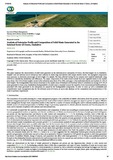Please use this identifier to cite or link to this item:
https://cris.library.msu.ac.zw//handle/11408/1273Full metadata record
| DC Field | Value | Language |
|---|---|---|
| dc.contributor.author | Jerie, Steven | - |
| dc.date.accessioned | 2016-05-10T15:25:19Z | - |
| dc.date.available | 2016-05-10T15:25:19Z | - |
| dc.date.issued | 2014 | - |
| dc.identifier.issn | 2314-6052 | - |
| dc.identifier.uri | http://dx.doi.org/10.1155/2014/865854 | - |
| dc.description.abstract | This paper examines the characteristics of solid waste generated in the informal sector enterprises of Gweru, the third largest city in Zimbabwe. Samples from the informal sector enterprises were collected in plastic bags and labelled with unique identity marks. The segregated components were measured to determine percentages of total weight of a sample. The data collected during the two seasons were analysed statistically using ANOVA to identify key similarities and differences. The major components of the waste stream include food and vegetable wastes in the market areas (from 18 to 51% of total weight), metals in the industrial areas (from 19 to 36%), and paper in the residential suburbs and markets (9–11% of total weight). The biodegradable waste stream dominates in the market areas of Kudzanai and Kombayi where it constitutes an average of 57.1% of waste generated in these areas. Establishing biodegradability of solid waste is essential because the majority of environmental and health problems associated with waste generated in the enterprises are caused by the biodegradable components. In order to come up with a sustainable and comprehensive waste management plan for the informal sector of Gweru, an up-to-date database on the composition and characteristics of the waste is a primary requirement. 1. Introduction The cornerstone of successful planning for a waste management program is the availability of reliable information about the quantity and type of material being generated and an understanding about how much of that material collection managers can expect to prevent or capture. Effective waste management through waste composition studies is thus vital for a number of reasons including the need to estimate material potential, to identify sources of component generation, to facilitate design of processing equipment, to estimate physical, chemical, and thermal properties of waste, and to maintain compliance with national and international laws. It is universally accepted that the quantity, characteristics, and composition of refuse vary according to socioeconomic status, food habits, local customs, geographical location, occupations, and climatic conditions [1–6]. Wastes are characterised on the basis of weight generated in kilograms per person per day (kg/person·day) and density in cubic metres and composition [1, 7–11]. In developing countries, there is little data on generation and types of waste. Generally the relationship between municipal solid waste generation and factors varies with the developmental stage of a nation. In a developing. | en_US |
| dc.language.iso | en | en_US |
| dc.publisher | Hindawi Publishing Corporation | en_US |
| dc.relation.ispartofseries | Journal of Waste Management;Vol. 2014 | - |
| dc.subject | Enterprise profile | en_US |
| dc.subject | Composition, solid waste | en_US |
| dc.title | Analysis of enterprise profile and composition of solid waste generated in the informal sector of Gweru, Zimbabwe | en_US |
| dc.type | Article | en_US |
| item.fulltext | With Fulltext | - |
| item.languageiso639-1 | en | - |
| item.openairecristype | http://purl.org/coar/resource_type/c_18cf | - |
| item.grantfulltext | open | - |
| item.openairetype | Article | - |
| item.cerifentitytype | Publications | - |
| Appears in Collections: | Research Papers | |
Files in This Item:
| File | Description | Size | Format | |
|---|---|---|---|---|
| Analysis of Enterprise Profile and Comp...the Informal Sector of Gweru, Zimbabwe.pdf | 17.75 MB | Adobe PDF |  View/Open |
Page view(s)
38
checked on Jul 26, 2024
Download(s)
10
checked on Jul 26, 2024
Google ScholarTM
Check
Items in MSUIR are protected by copyright, with all rights reserved, unless otherwise indicated.



